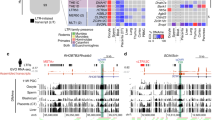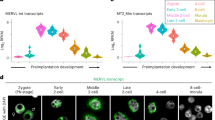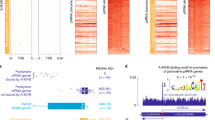Abstract
By comparing mammalian genomes, we and others have identified actively transcribed Ty3/gypsy retrotransposon-derived genes with highly conserved DNA sequences and insertion sites1,2,3,4,5,6. To elucidate the functions of evolutionarily conserved retrotransposon-derived genes in mammalian development, we produced mice that lack one of these genes, Peg10 (paternally expressed 10)1,2,3,7, which is a paternally expressed imprinted gene on mouse proximal chromosome 6. The Peg10 knockout mice showed early embryonic lethality owing to defects in the placenta. This indicates that Peg10 is critical for mouse parthenogenetic development and provides the first direct evidence of an essential role of an evolutionarily conserved retrotransposon-derived gene in mammalian development.
This is a preview of subscription content, access via your institution
Access options
Subscribe to this journal
Receive 12 print issues and online access
$209.00 per year
only $17.42 per issue
Buy this article
- Purchase on Springer Link
- Instant access to full article PDF
Prices may be subject to local taxes which are calculated during checkout





Similar content being viewed by others
References
Ono, R. et al. A retrotransposon-derived gene, PEG10, is a novel imprinted gene located on human chromosome 7q21. Genomics 73, 232–237 (2001).
Volff, J., Korting, C. & Schartl, M. Ty3/Gypsy retrotransposon fossils in mammalian genomes: did they evolve into new cellular functions? Mol. Biol. Evol. 18, 266–270 (2001).
Butler, M., Goodwin, T., Simpson, M., Singh, M. & Poulter, R. Vertebrate LTR retrotransposons of the Tf1/sushi group. J. Mol. Evol. 52, 260–274 (2001).
Charlier, C. et al. Human-ovine comparative sequencing of a 250-kb imprinted domain encompassing the callipyge (clpg) locus and identification of six imprinted transcripts: DLK1, DAT, GTL2, PEG11, antiPEG11, and MEG8. Genome Res. 11, 850–862 (2001).
Lynch, C. & Tristem, M. A co-opted gypsy-type LTR-retrotransposon is conserved in the genomes of humans, sheep, mice, and rats. Curr. Biol. 13, 1518–1523 (2003).
Seitz, H. et al. Imprinted microRNA genes transcribed antisense to a reciprocally imprinted retrotransposon-like gene. Nat. Genet. 34, 261–262 (2003).
Shigemoto, K. et al. Identification and characterisation of a developmentally regulated mammalian gene that utilises -1 programmed ribosomal frameshifting. Nucleic Acids Res. 29, 4079–4088 (2001).
Ono, R. et al. Identification of a large novel imprinted gene cluster on mouse proximal chromosome 6. Genome Res. 13, 1696–1705 (2003).
Poulter, R. & Butler, M. A retrotransposon family from the pufferfish (fugu) Fugu rubripes. Gene 215, 241–249 (1998).
Beechey, C., Cattanach, B.M., Blake, A. & Peters, J. Mouse Imprinting Data and References, http://www.mgu.har.mrc.ac.uk/research/imprinting (2003).
Nagy, A., Rossant, J., Nagy, R., Abramow-Newerly, W. & Roder, J.C. Derivation of completely cell culture-derived mice from early-passage embryonic stem cells. Proc. Natl. Acad. Sci. USA 90, 8424–8428 (1993).
Guillemot, F. et al. Genomic imprinting of Mash2, a mouse gene required for trophoblast development. Nat. Genet. 9, 235–242 (1995).
Surani, M.A., Barton, S.C. & Norris, M.L. Development of reconstituted mouse eggs suggests imprinting of the genome during gametogenesis. Nature 308, 548–550 (1984).
McGrath, J. & Solter, D. Completion of mouse embryogenesis requires both the maternal and paternal genomes. Cell 37, 179–183 (1984).
Sturm, K.S., Flannery, M.L. & Pedersen, R.A. Abnormal development of embryonic and extraembryonic cell lineages in parthenogenetic mouse embryos. Dev. Dyn. 201, 11–28 (1994).
Moore, T. & Haig, D. Genomic imprinting in mammalian development: a parental tug-of-war. Trends Genet. 7, 45–49 (1991).
Constancia, M. et al. Placental-specific IGF-II is a major modulator of placental and fetal growth. Nature 417, 945–948 (2002).
Agrawal, A., Eastman, Q.M. & Schatz, D.G. Transposition mediated by RAG1 and RAG2 and its implications for the evolution of the immune system. Nature 394, 744–751 (1998).
Nakamura, T.M. & Cech, T.R. Reversing time: origin of telomerase. Cell 92, 587–590 (1998).
Smit, A.F. Interspersed repeats and other mementos of transposable elements in mammalian genomes. Curr. Opin. Genet. Dev. 9, 657–663 (1999).
Toh, H., Ono, M. & Miyata, T. Retroviral gag and DNA endonuclease coding sequences in IgE-binding factor gene. Nature 318, 388–389 (1985).
Mi, S. et al. Syncytin is a captive retroviral envelope protein involved in human placental morphogenesis. Nature 403, 785–789 (2000).
Dupressoir, A. et al. Syncytin-A and syncytin-B, two fusogenic placenta-specific murine envelope genes of retroviral origin conserved in Muridae. Proc. Natl. Acad. Sci. USA 102, 725–730 (2005).
Tsou, A.P. et al. Overexpression of a novel imprinted gene, PEG10, in human hepatocellular carcinoma and in regenerating mouse livers. J. Biomed. Sci. 10, 625–635 (2003).
Okabe, H. et al. Involvement of PEG10 in human hepatocellular carcinogenesis through interaction with SIAH1. Cancer Res. 63, 3043–3048 (2003).
Lux, A. et al. Human retroviral gag- and gag-pol-like proteins interact with the TGF-β receptor ALK1. J. Biol. Chem. 280, 8482–8493 (2005).
Hedges, S.B. The origin and evolution of model organisms. Nat. Rev. Genet. 3, 838–849 (2002).
Nagasaki, K. et al. Identification of a novel gene, LDOC1, down-regulated in cancer cell lines. Cancer Lett. 140, 227–234 (1999).
Brandt, J. et al. Transposable elements as a source of genetic innovation: expression and evolution of a family of retrotransposon-derived neogenes in mammals. Gene 345, 101–111 (2005).
Horike, S., Cai, S., Miyano, M., Cheng, J.F. & Kohwi-Shigematsu, T. Loss of silent-chromatin looping and impaired imprinting of DLX5 in Rett syndrome. Nat. Genet. 37, 31–40 (2005).
Acknowledgements
We thank M.A. Surani and S. Barton for helpful suggestions on this manuscript. We also thank S. Aizawa for providing the DT-A vector, J. Miyazaki for the Cre-recombinase expression vector, E. Robertson for the CCE ES cells, H. Sasaki for the Gallus gallus genome, Y. Nakahara and M. Takabe of the Mitsubishi Kagaku Institute of Life Sciences for animal breeding, and S. Ichinose and T. Tajima of Tokyo Medical and Dental University and N. Kawabe and H. Hasegawa of Tokai University for assistance with the in situ hybridization experiments. This work was supported by grants from Research Fellowships of the Japan Society for the Promotion of Science for young Scientists (JSPS) to R.O.; the Asahi Glass Foundation to T.K.-I.; and CREST (the research program of the Japan Science and Technology Agency (JST)), the Uehara Memorial Science Foundation, the Ministry of Health, Labour and Welfare for Child Health and Development (14-C) and the Ministry of Education, Culture, Sports, Science and Technology of Japan to F.I.
Author information
Authors and Affiliations
Corresponding authors
Ethics declarations
Competing interests
The authors declare no competing financial interests.
Supplementary information
Supplementary Fig. 1
Placental morphology is normal until 8.5 d.p.c. (PDF 2856 kb)
Supplementary Fig. 2
Fetal-to-placental weight ratios. (PDF 90 kb)
Supplementary Fig. 3
Production of Peg10 loxP KO mice, partial pedigrees of the Peg10 loxP KO mice and the relative expression levels of Peg10 Pat-loxP-KO embryos. (PDF 604 kb)
Supplementary Fig. 4
Peg10 loxP KO embryos show severe growth retardation and placental defects. (PDF 2205 kb)
Supplementary Fig. 5
Rescue of Peg10 Pat-KO embryos by tetraploid wild-type extraembryonic tissues. (PDF 1261 kb)
Supplementary Fig. 6
Expression profile of Ascl2 in Peg10 Pat-KO placentas. (PDF 135 kb)
Supplementary Fig. 7
Comparative genomic analysis of Sgce and Ppp1r9a. (PDF 180 kb)
Supplementary Table 1
Lethality of Peg10 lox-P KO (Pat-lox-P KO) fetuses (PDF 69 kb)
Rights and permissions
About this article
Cite this article
Ono, R., Nakamura, K., Inoue, K. et al. Deletion of Peg10, an imprinted gene acquired from a retrotransposon, causes early embryonic lethality. Nat Genet 38, 101–106 (2006). https://doi.org/10.1038/ng1699
Received:
Accepted:
Published:
Issue Date:
DOI: https://doi.org/10.1038/ng1699
This article is cited by
-
Paternal Expressed Gene 10 (PEG10) is decreased in early-onset preeclampsia
Reproductive Biology and Endocrinology (2023)
-
Targeting PEG10 as a novel therapeutic approach to overcome CDK4/6 inhibitor resistance in breast cancer
Journal of Experimental & Clinical Cancer Research (2023)
-
α1,3-fucosylation of MEST promotes invasion potential of cytotrophoblast cells by activating translation initiation
Cell Death & Disease (2023)
-
Placental imprinting of SLC22A3 in the IGF2R imprinted domain is conserved in therian mammals
Epigenetics & Chromatin (2022)
-
Folate deficiency disturbs PEG10 methylation modifications in human spina bifida
Pediatric Research (2022)



